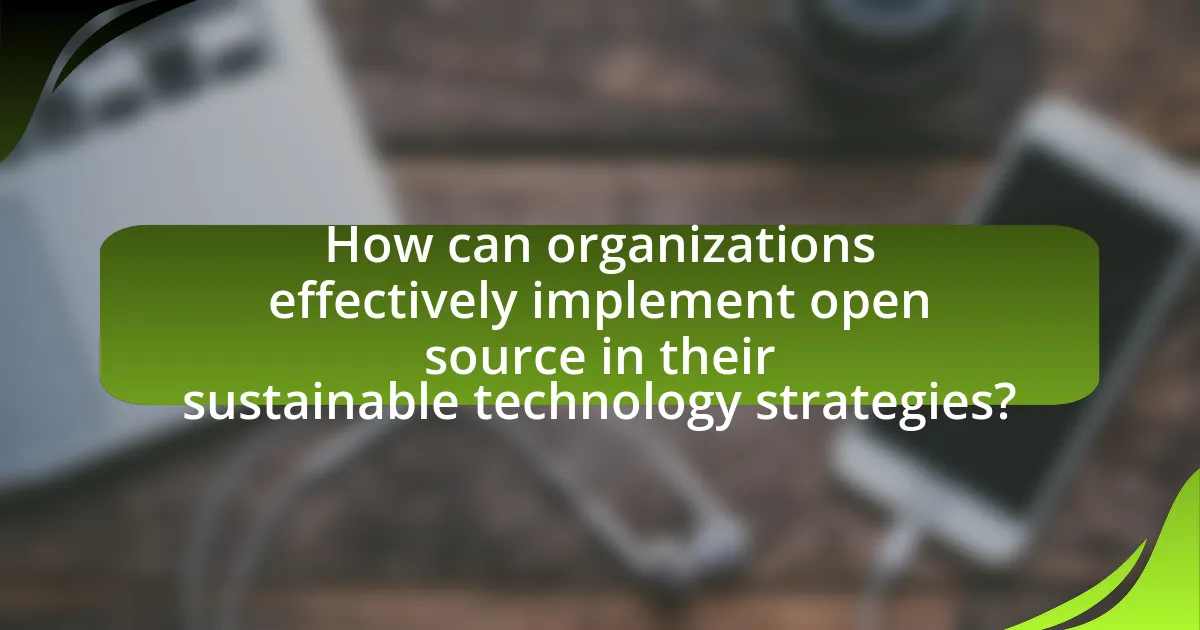Open source plays a vital role in advancing sustainable technology by promoting collaboration, innovation, and transparency. It enables developers and organizations to access, modify, and distribute software freely, leading to rapid advancements in addressing environmental challenges. Key principles such as community-driven development and resource sharing enhance efficiency and reduce costs, while active community involvement fosters inclusivity and adaptability in technology solutions. The article explores how open source contributes to sustainability, the benefits it offers, and the practical steps organizations and individuals can take to leverage open source for sustainable practices.

What is the Importance of Open Source in Sustainable Technology?
Open source is crucial in sustainable technology as it fosters collaboration, innovation, and transparency. By allowing developers and organizations to access, modify, and distribute software freely, open source projects can rapidly evolve to meet environmental challenges. For instance, the Open Source Ecology project aims to create sustainable technologies through community-driven development, demonstrating how shared knowledge can lead to efficient solutions. Furthermore, studies show that open source software can reduce costs and improve the sustainability of technology by enabling the reuse of existing code and minimizing waste. This collaborative approach not only accelerates technological advancements but also promotes ethical practices in sustainability.
How does open source contribute to sustainability in technology?
Open source contributes to sustainability in technology by promoting collaboration and resource sharing, which reduces redundancy and waste. By allowing developers to access, modify, and distribute code freely, open source projects enable more efficient use of resources, as multiple organizations can build upon existing work rather than starting from scratch. For instance, the Open Source Initiative reports that open source software can lead to lower costs and reduced environmental impact by minimizing the need for proprietary software licenses and the associated energy consumption in development and deployment. This collaborative approach fosters innovation and accelerates the development of sustainable technologies, as seen in projects like Linux and Apache, which have significantly influenced the tech landscape while encouraging environmentally friendly practices.
What are the key principles of open source that support sustainability?
The key principles of open source that support sustainability include transparency, collaboration, and community-driven development. Transparency allows users to inspect and modify the source code, ensuring that software is free from hidden flaws and promoting trust. Collaboration fosters innovation by enabling diverse contributors to work together, sharing knowledge and resources, which can lead to more efficient and sustainable solutions. Community-driven development emphasizes the importance of user feedback and participation, ensuring that the software evolves to meet real-world needs, thereby enhancing its longevity and relevance. These principles collectively contribute to sustainable technology by promoting resource efficiency, reducing waste, and encouraging continuous improvement.
How does open source foster collaboration in sustainable technology?
Open source fosters collaboration in sustainable technology by providing a transparent platform where developers and organizations can share knowledge, resources, and innovations. This collaborative environment accelerates the development of sustainable solutions, as seen in projects like OpenSolar, which allows users to access and contribute to solar energy technologies. The open-source model encourages diverse participation, leading to a wider range of ideas and solutions, exemplified by the success of the Open Source Ecology project, which aims to create open-source blueprints for sustainable living. By removing barriers to entry, open source enables collective problem-solving and innovation, ultimately driving advancements in sustainable technology.
Why is open source crucial for innovation in sustainable technology?
Open source is crucial for innovation in sustainable technology because it fosters collaboration and accelerates the development of solutions. By allowing developers and researchers to access, modify, and share code, open source projects enable diverse contributions that can lead to more efficient and effective sustainable technologies. For instance, the Open Source Ecology project has created a set of open-source blueprints for sustainable farming equipment, demonstrating how shared knowledge can lead to practical innovations that address environmental challenges. This collaborative approach not only reduces costs but also enhances the adaptability of technologies to local needs, ultimately driving greater impact in sustainability efforts.
What role does community involvement play in open source projects?
Community involvement is crucial in open source projects as it fosters collaboration, enhances innovation, and ensures sustainability. Active participation from diverse contributors leads to a richer pool of ideas and solutions, which can accelerate development and improve software quality. For instance, projects like Linux and Apache thrive due to their vibrant communities, which not only contribute code but also provide support, documentation, and testing. This collective effort results in more robust and adaptable software, ultimately driving the success and longevity of open source initiatives.
How does open source accelerate the development of sustainable solutions?
Open source accelerates the development of sustainable solutions by fostering collaboration and innovation among diverse contributors. This collaborative environment allows for rapid sharing of ideas, resources, and technologies, which leads to faster problem-solving and the creation of more efficient sustainable practices. For instance, projects like OpenStreetMap have enabled communities to develop localized solutions for environmental challenges by leveraging collective data and expertise. Additionally, studies show that open source software can reduce costs and increase accessibility, making sustainable technologies more available to a broader audience, thus enhancing their adoption and impact.

What are the benefits of open source in promoting sustainable practices?
Open source software promotes sustainable practices by enabling collaboration, reducing costs, and fostering innovation. Collaboration among developers and organizations leads to shared resources and knowledge, which accelerates the development of sustainable technologies. For instance, projects like OpenStreetMap allow communities to contribute to mapping efforts, enhancing local resource management and environmental monitoring. Additionally, open source solutions often have lower licensing fees, making sustainable technologies more accessible to a wider range of users, including non-profits and small businesses. This accessibility can lead to increased adoption of eco-friendly practices. Furthermore, the transparency of open source code allows for continuous improvement and adaptation, ensuring that sustainable solutions can evolve with changing environmental needs.
How does open source reduce costs for sustainable technology initiatives?
Open source reduces costs for sustainable technology initiatives by eliminating licensing fees and enabling collaborative development. This model allows organizations to share resources, knowledge, and innovations, significantly lowering the financial barriers associated with proprietary software. For instance, a study by the Open Source Initiative found that companies using open source solutions can save up to 90% on software costs compared to traditional licensing models. Additionally, the collaborative nature of open source fosters rapid innovation and reduces duplication of efforts, further driving down costs associated with research and development.
What are the financial advantages of using open source software?
The financial advantages of using open source software include significant cost savings, reduced vendor lock-in, and the potential for increased innovation. Organizations can avoid high licensing fees associated with proprietary software, as open source software is typically available for free. According to a 2020 study by the European Commission, companies that adopted open source solutions reported an average cost reduction of 30% in software expenses. Additionally, open source software allows for greater flexibility and customization, enabling businesses to tailor solutions to their specific needs without incurring additional costs from vendors. This adaptability fosters innovation, as organizations can modify and improve the software, leading to enhanced productivity and efficiency.
How does open source enable resource sharing among organizations?
Open source enables resource sharing among organizations by providing access to publicly available software and tools that can be collaboratively developed and improved. This collaborative model allows organizations to share code, documentation, and best practices, reducing duplication of effort and fostering innovation. For example, projects like Linux and Apache demonstrate how multiple organizations can contribute to and benefit from shared resources, leading to cost savings and enhanced capabilities. Additionally, studies show that organizations leveraging open source can accelerate development cycles and improve software quality through community contributions and peer reviews.
What impact does open source have on accessibility and inclusivity in technology?
Open source significantly enhances accessibility and inclusivity in technology by allowing diverse communities to collaborate on software development, ensuring that tools are adaptable to various needs. This collaborative nature enables developers from different backgrounds, including those with disabilities, to contribute to and improve software, leading to more user-friendly and accessible applications. For instance, projects like Mozilla Firefox and LibreOffice have incorporated accessibility features based on community feedback, demonstrating how open source fosters an inclusive environment. Additionally, a 2021 study by the Open Source Initiative found that open source projects are 30% more likely to include accessibility features compared to proprietary software, highlighting the positive impact of open source on creating technology that serves a broader audience.
How does open source software enhance access to sustainable technology?
Open source software enhances access to sustainable technology by providing free and collaborative tools that enable innovation and adaptation. This collaborative model allows developers and organizations to modify and improve software, leading to more efficient and environmentally friendly solutions. For instance, projects like OpenSolar and OpenEnergyMonitor demonstrate how open source platforms can facilitate the development of renewable energy technologies, making them more accessible to communities worldwide. By removing financial barriers and fostering community-driven improvements, open source software accelerates the adoption of sustainable practices and technologies.
What are the implications of open source for marginalized communities?
Open source has significant implications for marginalized communities by providing access to technology, fostering collaboration, and promoting empowerment. Access to open source software allows these communities to utilize tools without the burden of licensing fees, which can be prohibitive. For instance, the availability of open source educational resources enables individuals in low-income areas to learn valuable skills that can enhance their employability.
Moreover, open source projects often encourage community participation, allowing marginalized groups to contribute to and shape the technology that affects their lives. This participatory approach can lead to solutions that are more relevant and effective for their specific needs. A study by the Open Source Initiative highlights that open source initiatives can bridge the digital divide by enabling local developers to create culturally relevant applications, thus fostering innovation from within the community.
Additionally, open source promotes transparency and accountability, which can empower marginalized communities to advocate for their rights and interests. By having access to the source code, these communities can understand how technologies work and ensure they are not being exploited or surveilled. Overall, the implications of open source for marginalized communities are profound, as it enhances access, fosters collaboration, and empowers individuals to take control of their technological landscape.

How can organizations effectively implement open source in their sustainable technology strategies?
Organizations can effectively implement open source in their sustainable technology strategies by integrating open source software and practices into their development processes. This integration allows organizations to leverage community-driven innovation, reduce costs associated with proprietary software, and enhance collaboration across teams. For instance, a study by the Linux Foundation in 2020 revealed that 90% of organizations reported using open source software, highlighting its widespread acceptance and effectiveness in driving technological advancements. Additionally, organizations can contribute to open source projects, which fosters a culture of sustainability and shared knowledge, ultimately leading to more resilient and adaptable technology solutions.
What best practices should organizations follow when adopting open source solutions?
Organizations should follow several best practices when adopting open source solutions to ensure successful implementation and sustainability. First, they should conduct thorough evaluations of the open source software to assess its community support, security, and compatibility with existing systems. Research indicates that software with strong community backing tends to receive more frequent updates and security patches, which enhances reliability.
Second, organizations must establish clear governance policies that define roles, responsibilities, and processes for managing open source contributions and usage. This is crucial for maintaining compliance with licensing requirements and ensuring that contributions align with organizational goals.
Third, organizations should invest in training and support for their teams to build expertise in using and contributing to open source projects. A study by the Linux Foundation found that organizations with trained personnel are more likely to successfully integrate open source solutions.
Finally, organizations should actively participate in the open source community by contributing back to projects, which fosters collaboration and innovation. Engaging with the community not only helps improve the software but also enhances the organization’s reputation and influence within the ecosystem.
How can organizations ensure compliance with open source licenses?
Organizations can ensure compliance with open source licenses by implementing a robust open source policy that includes regular audits and training for employees. This policy should clearly outline the procedures for using, modifying, and distributing open source software, ensuring that all team members understand their responsibilities. Regular audits help identify any potential compliance issues, while training sessions educate employees on the specific licenses associated with the software they use. According to the Open Source Initiative, adherence to these practices significantly reduces the risk of legal disputes and fosters a culture of respect for intellectual property rights.
What strategies can be employed to foster a culture of open source within organizations?
To foster a culture of open source within organizations, leadership must actively promote transparency and collaboration. This can be achieved by implementing policies that encourage sharing code and resources, providing training on open source practices, and recognizing contributions to open source projects. For instance, organizations like Red Hat have successfully integrated open source principles by creating a community-driven environment where employees are incentivized to contribute to open source initiatives, leading to increased innovation and employee engagement. Additionally, establishing partnerships with open source communities can enhance knowledge sharing and resource availability, further embedding open source values within the organizational culture.
What challenges might organizations face when integrating open source into sustainable technology?
Organizations may face several challenges when integrating open source into sustainable technology, including compatibility issues, lack of support, and security vulnerabilities. Compatibility issues arise when open source software does not seamlessly integrate with existing systems, leading to increased costs and delays in implementation. The lack of support can hinder organizations, as open source projects often rely on community contributions, which may not provide timely or adequate assistance. Additionally, security vulnerabilities are a significant concern, as open source software can be more susceptible to attacks if not properly maintained or audited. These challenges can impede the effective adoption of open source solutions in sustainable technology initiatives.
How can organizations overcome resistance to open source adoption?
Organizations can overcome resistance to open source adoption by implementing comprehensive training programs and fostering a culture of collaboration. Training equips employees with the necessary skills to effectively use open source tools, addressing concerns about usability and support. For instance, a study by the Linux Foundation found that organizations that invested in training saw a 30% increase in open source project contributions. Additionally, promoting a collaborative environment encourages knowledge sharing and reduces apprehension towards new technologies, as evidenced by companies like Red Hat, which successfully integrated open source by emphasizing community involvement and support.
What are the common misconceptions about open source in sustainability?
Common misconceptions about open source in sustainability include the belief that open source software lacks quality and support, that it is only suitable for small projects, and that it cannot be integrated into larger systems. In reality, many open source projects, such as Linux and Apache, have proven high quality and extensive community support. Additionally, open source is increasingly used in large-scale applications, as seen in organizations like NASA and the European Space Agency, which leverage open source for complex sustainability projects. These examples demonstrate that open source can effectively contribute to sustainability efforts at all scales.
What are the future trends of open source in sustainable technology?
Future trends of open source in sustainable technology include increased collaboration among developers, enhanced transparency in sustainability practices, and the rise of community-driven projects. Collaboration is expected to grow as organizations and individuals recognize the value of shared resources, leading to faster innovation and problem-solving in sustainability challenges. Transparency will improve as open source projects allow stakeholders to scrutinize and verify sustainability claims, fostering trust and accountability. Community-driven projects will likely gain momentum, empowering local initiatives and enabling tailored solutions that address specific environmental issues. These trends are supported by the growing adoption of open source software in sectors like renewable energy and waste management, where collaborative efforts have already demonstrated significant impact.
How is the role of open source evolving in the context of global sustainability goals?
The role of open source is evolving significantly in the context of global sustainability goals by facilitating collaboration and innovation in sustainable technologies. Open source projects enable diverse stakeholders, including governments, NGOs, and private sectors, to share knowledge and resources, which accelerates the development of solutions addressing climate change and resource management. For instance, the Open Source Ecology project aims to create open-source blueprints for sustainable farming equipment, demonstrating how shared resources can lead to more efficient agricultural practices. Additionally, the use of open source software in renewable energy systems, such as solar and wind, allows for cost-effective and customizable solutions that can be adapted to local needs, further supporting sustainability objectives.
What emerging technologies are likely to benefit from open source approaches?
Emerging technologies that are likely to benefit from open source approaches include artificial intelligence, blockchain, and the Internet of Things (IoT). Open source frameworks in artificial intelligence, such as TensorFlow and PyTorch, facilitate collaboration and innovation, allowing developers to build upon existing models and share improvements. In blockchain, open source platforms like Ethereum enable transparency and community-driven development, fostering trust and security in decentralized applications. The IoT sector benefits from open source protocols, which promote interoperability and reduce vendor lock-in, enhancing device communication and integration. These technologies demonstrate that open source methodologies can accelerate development, enhance security, and foster community engagement, ultimately driving sustainable technological advancements.
What practical steps can individuals take to support open source in sustainable technology?
Individuals can support open source in sustainable technology by actively contributing to projects, sharing knowledge, and promoting awareness. Contributing to projects can involve coding, testing, or documentation, which enhances the quality and reach of sustainable technology solutions. Sharing knowledge through blogs, workshops, or social media helps disseminate information about open source tools and their benefits, fostering a community of practice. Promoting awareness can include advocating for open source solutions in local organizations or participating in events that highlight sustainable technology initiatives. These actions collectively strengthen the open source ecosystem, making sustainable technology more accessible and effective.



